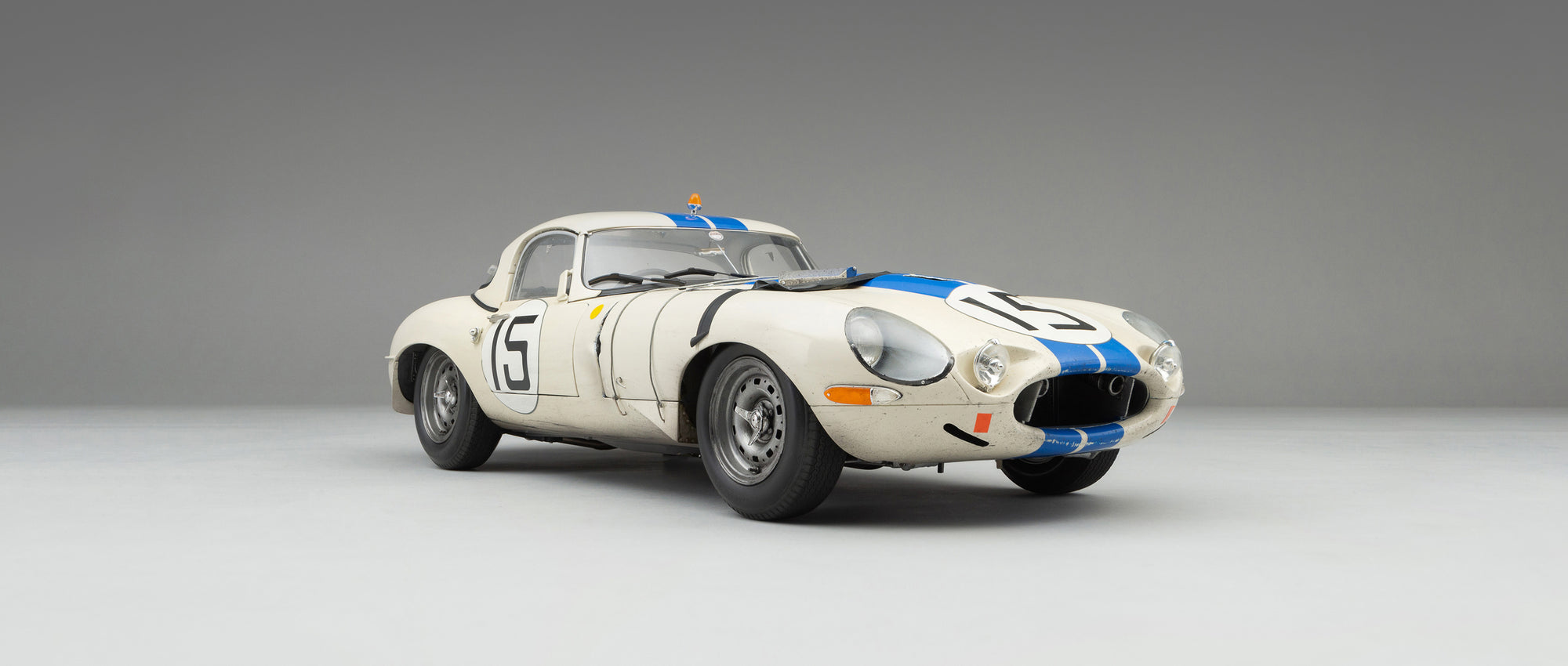Technical Details
- Description
- Scale guide
- Limited to just 5 pieces
- Weathering details precisely applied by artisans in Bristol using archival imagery
- Model accompanied by an archive quality Giclée print of the car at Le Mans in 1963
- 1:8 scale model, over 55 cms/22 inches long
- Each model hand-built and assembled by a small team of craftsmen
- Made using the finest quality materials
- Over 3500 hours to develop the model
- Over 400 hours to build and weather each model
- Thousands of precisely engineered parts: castings, photo-etchings and CNC machined metal components
- Base model built using a digital scan of an original LWE and paint codes supplied by Jaguar Heritage
- Officially licensed 24 Hours of Le Mans product
Only one model remaining in this edition of just five models
We are delighted to introduce a new race weathered project at 1:8 scale: a special Limited Edition of five artistically race weathered models of the Jaguar E-type Lightweight (XKE) as driven at the 1963 24 Hours of Le Mans by American duo Briggs Cunningham and Bob Grossman on the 15th and 16th of June 1963. Each of these five models has been meticulously hand-painted and detailed by our artisans in Bristol to show every detail of the race dirt that adorned the hastily repaired car after its 24 hours of tough competition at Circuit de la Sarthe.
The weathering details are precisely applied by our artisans using archival imagery to ensure the completed model is a perfect replica of the real car as it finished the race in 1963. Each model is accompanied by an archive quality Giclée print of the car as it crossed the line, selected by Amalgam from the Motorsport Images collection. The base model was developed using data supplied by Jaguar Heritage, who also scrutinised the resulting prototype to ensure complete accuracy of the model.
The Jaguar E-type was never meant to race. Its sweeping bodywork certainly took inspiration from the sleek aerodynamic profiles of the racing C-types and D-types, and its monocoque chassis and disc brakes had been race-honed at Le Mans, but the E-type's innovative independent rear suspension was designed to be B-road friendly, while the 3.8-litre straight-six XK engine was tuned to be easier to drive at low speed. As demand for E-types outstripped production capacity at the Jaguar Brown's Lane factory, there was little need for the E-type to go racing. Indeed, road car production took priority over a return to motorsport.
In 1961 though, the FIA created a GT category for production sports cars into which the E-type fit perfectly. Lacking the time and resources to build a dedicated competition sports car from scratch, Jaguar hatched a plan to build an ultra-lightweight E-type using aluminium panels and a modified lighter version of the XK engine, with an aluminium block in place of the regular cast-iron. The Lightweight E-type's design was partly inspired by an early one-off 'Low-drag Coupé' concept that had been created in 1962 by Jaguar's pioneering aerodynamicist Malcolm Sayer. It used aluminium panels to reduce weight, which were riveted and glued to the monocoque to improve chassis stiffness. The aerodynamics were optimised, with a fast rake to the windscreen and an even more curvaceous form than the standard E-type at the rear, while the interior was stripped of all unneeded comfort features. Every piece of glass, except the windscreen, was replaced with Plexiglas. In 1963, Jaguar committed to a limited run of Lightweight E-types, using even more aluminium in the body and a lightweight aluminium block for the race-spec 350bhp 3.8-litre XK engine. This time the car was based on an E-type convertible, with a coupé hard top fitted as standard. The imminent arrival of the Lightweight E-type worried great rival Enzo Ferrari so much that he immediately commissioned the lighter and more powerful Ferrari 250 GTO. At the time, only 12 of the planned 18 cars were built. Jaguar would decide to build the six remaining cars, finally utilising their unused chassis codes, in 2014.
The first two purpose-built Lightweight E-types were shipped to the US to take part in the 1963 Sebring 12 Hours. Ed Leslie and Frank Morrill placed seventh overall and first in class for Kjell Qvale, whilst Bruce McLaren and Walt Hansgen finished a further lap back in eighth overall and second in class for Briggs Cunningham. At Le Mans later that year, three cars were entered. Gearbox issues and a serious accident dampened aspirations within the first six hours, taking two of the trio of cars out of the race, whilst a two-hour delay caused by a brake issue meant the remaining Briggs Cunningham could only manage nineth overall and second in class. Results in non-endurance events during 1963 were much better, with Graham Hill taking victories at twisty British circuits Snetterton, Goodwood and Silverstone, where the torque of the 3.8-litre straight-six XK engine could propel the Jaguar out of corners faster than Ferrari's 3-litre V12. Although the Lightweight E-type never matched the success of the C-type and D-type at Le Mans and Sebring, the car remains one of the most celebrated racing sports cars to emerge from post-war Britain, thoroughly earning their reputation as ‘GTO Killers’ and becoming a true rarity amongst Jaguar classics.
This fine 1:8 scale model is of the #15 Jaguar Lightweight E-type (XKE) as driven at the 1963 edition of the 24 Hours of Le Mans by American duo Briggs Cunningham and Bob Grossman on the 15th and 16th of June 1963. Cunningham, who had raced Jaguar's E2A prototype in the 1960 race, had given the standard E-type its Le Mans debut in 1962, earning fourth place and class win alongside Roy Salvadori, ahead of a second E-type driven by Peter Sargent and Peter Lumsden. The next year, Cunningham was back, this time armed with three Lightweights and official support from the factory. Cunningham drove with Bob Grossman with his other regular drivers Walt Hansgen and Salvadori paired with Augie Pabst and Paul Richards in the #14 and #16 cars respectively. The #14 car withdrew after an hour, suffering from gearbox issues, whilst the #16 was involved in a terrible crash after six hours, which unfortunately killed Brazilian driver Christian ‘Bino’ Heins. Fortunately for Salvadori, he had been unable to do up his full harness and was thrown out the rear window as the car burst into flames, suffering serious injury but surviving. The #15 of Cunningham and Grossman persevered, moving steadily into the top-10 through the night. However, on Sunday morning the brake pedal snapped as Grossman came to the end of the Mulsanne straight. The car slammed through three rows of haybales, scattering spectators, but he was able to get the car back to the pits. Stealing parts from the #14 car that remained intact, they lost two hours but got back into the race. Grossman and Cunningham crossed the finish line in ninth position overall and second in class. One can only speculate how well the car might have finished were it not for its brake pedal failure.
The Race Weathered Jaguar E-type Lightweight - 1963 Le Mans is limited to just 5 pieces.
Handling Race Weathered Models
Please note that Amalgam’s weathered models are incredibly fragile and require careful handling. We recommend you keep handling to a minimum to avoid removing the weathered effects from the model. When handling the model, please adhere to the instructions included with the product when purchased. The brush featured in the gallery is included purely for demonstrating the scale of the model. We do not advise any cleaning of our weathered models as this may remove some of the weathering applications.
--------------------------------------------------------------
Elevate your 1:8 scale collection with one of our elegant, harmonious and handcrafted display cabinets, stands or plinths.
Pre-order
Bespoke
In order for us to create your bespoke model, you will need to choose 4 extra options. Paint colour, interior colour, wheel style and caliper colour.
Please complete the form and a member of our Sales Team will contact you.
Contact Us
Please contact us for more information about ordering this model.






